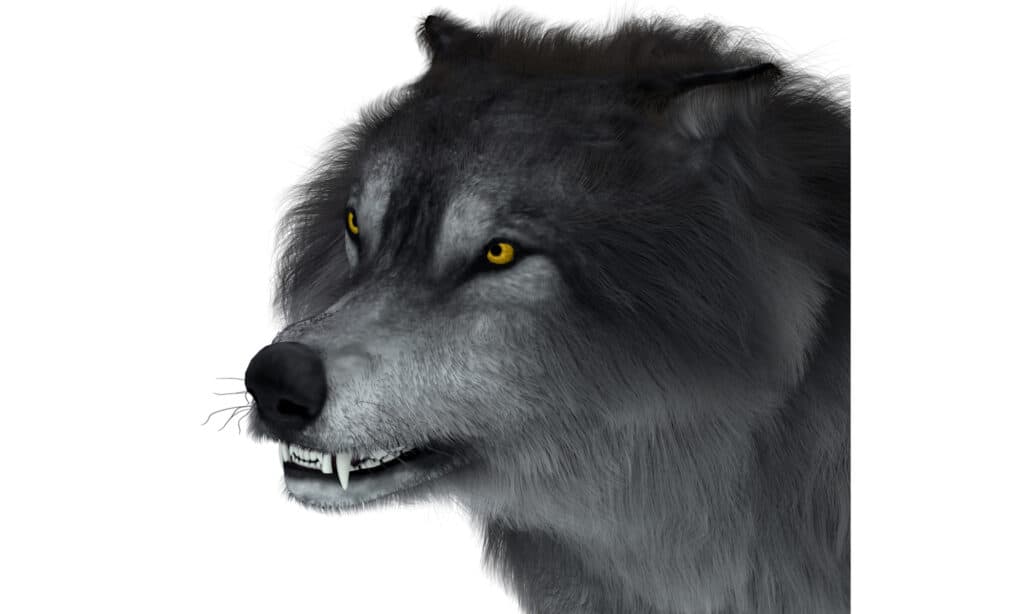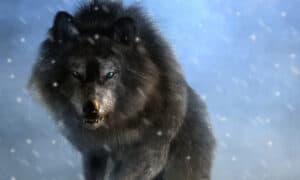You might initially assume that a dire wolf is an imaginary creature. The same as a unicorn or a fire-breathing dragon. After all, they were featured in George R.R. Martin’s fantasy novels and TV series Game of Thrones. It is reasonable to assume that dire wolves did not exist in our world. You would, however, be gravely mistaken! A dire wolf is a real animal that eventually went extinct. There is evidence that the wolves that we now call dire wolves (Canis dirus) patrolled North America during Earth’s last ice age.
Have you ever wondered what these prehistoric creatures were like? Do you want to know why and when dire wolves went extinct? Here you will discover everything you need to know about the dire wolf and its sad extinction.
What Were Dire Wolves?

The dire wolf is considered to be one of the most prevalent and widespread large carnivores in Pleistocene America.
©Catmando/Shutterstock.com
The dire wolf is considered to be one of the most prevalent and widespread large carnivores in Pleistocene America. Dire wolves were about the same length as gray wolves, but they weighed between 125 and 175 pounds more than their modern cousins (Canis lupus). The wolves likely hunted bison, ancient horses, and even small mastodons and mammoths in packs, as other wolves do today.
Unlike C. lupus, the dire wolf had larger teeth with greater shearing ability, and its bite force at the canine tooth was stronger than any other known canine. Researchers estimate that dire wolves could bite with 129 percent of the force available to gray wolves, hyenas, and felids. Because their canines were flexible and rounded, it was better suited to battling prey as well. Dire wolves were, therefore, bone-crushing canids.
There is no question that the dire wolf was one of the most formidable predators of prehistoric times. It is safe to say that we would not want to cross paths with one. With a better understanding of this ferocious predator, let’s discover where and when they lived.
When Did Dire Wolves Inhabit The Earth?
Dire wolves existed during the Pleistocene Epoch (2.6 million to 11,700 years ago). It is estimated that dire wolves inhabited North America between 250,000 and 13,000 years ago. There have been skeletal remains found in Florida, the Mississippi River valley, and the Valley of Mexico, indicating the species was widespread.
In fact, the largest concentration of dire wolves was found in California. At the La Brea Tar Pits in downtown Los Angeles, there are the skeletons of thousands of dire wolves mixed with those of saber-toothed tigers (genus Smilodon). There’s no doubt that these two predators were living in the same habitat and hunting the same kind of prey. If extreme conditions forced them to, they might have stalked each other and fought to the death.
A display case at the Page Museum inside the tar pits at La Brea is an awesome place to see nearly 400 skulls of Canis dirus that were found during the excavation of the pits. It’s not the end of the story, either. The pits have produced more than 200,000 specimens of dire wolves. Saber-toothed cats are the second most common mammals found in the La Brea tar pits, after dire wolves. La Brea’s mammalian fossils are dominated by carnivores, with around 90 percent being carnivores.
So when did this monstrous hunter go extinct? Let’s find out!
When Did Dire Wolves Go Extinct & What Caused It?

The dire wolf roamed for at least 250,000 years.
©Catmando/Shutterstock.com
Throughout the Americas, the dire wolf roamed for at least 250,000 years. The dire wolf is technically referred to as a “hypercarnivore,” which sounds a lot scarier than it actually is because it is a large predator. This means that the dire wolf ate mostly meat. In fact, their diet consisted of at least 70% meat. Accordingly, most mammalian predators of the Cenozoic Era and domestic cats and dogs of today are hypercarnivores. Also, hypercarnivores have large, slicing canine teeth that have evolved to cut through prey flesh easily.
Is there any connection between all of this and when dire wolves went extinct? There was an end to the dire wolf around 13,000 years ago at the end of the last ice age.
Researchers generally agree that dire wolves targeted large herbivores for hunting. Moreover, meat constituted a large portion of their diet, as we mentioned above. About 13,000 years ago, many of these large herbivores, including horses, bison, and camels, became extinct or dramatically declined in North America. This is almost certainly the reason dire wolves became extinct because their prey disappeared from the landscape. In contrast, when it comes to the gray wolf, it is more flexible and adaptable so that it can survive on a wider variety of foods. As a result, the dire wolf became extinct while other forms of wolves survived.
One Organization Is Trying To “Bring Back” Dire Wolves

Dire wolves were incredibly powerful animals during their prime, as seen in the picture above. It is for this reason that so many people feel sad about their extinction. In fact, the sad reality has compelled one group to work on an amazing project.
It seems that one organization has decided to try to bring the dire wolf back. That doesn’t mean bringing them back through zombie methods, or like in Stephen King’s Pet Sematary. It has been the mission of the American Alsatian Breeders Association since 1988 to restore the look of the large prehistoric dire wolf by combining various dog breeds. Breeding results have produced dogs whose appearance is described as ‘wolfish.’ You will, however, have to pay a pretty penny if you want to own your own ‘dire wolf.’ A puppy starts at $3,000, and there’s a pretty long waiting list.
Still, wouldn’t it be great to have your very own ‘dire wolf?’
Dire Wolf Vs. Gray Wolf
It is believed that the dire wolf and the gray wolf are descended from two different species, therefore making the dire wolf a completely different animal than that of today’s wolf. Scientists believed that the dire wolf was descended from Armbruster’s Wolf, while the gray wolf comes from the Hare-eating wolf, although based on recent genetic research, it is now thought that the closest relative of the dire wolf is the African jackal.
The dire wolf was heavier and had massive teeth and jaws. They were about twenty percent bigger than the gray wolf, and although their legs were relatively shorter, they had larger pelvic bones and shoulder blades. They weighed between 130 and 175 pounds. The gray wolf is a lot leaner, with an average weight between 66 and 145 pounds.
The photo featured at the top of this post is © Daniel Eskridge/Shutterstock.com
Thank you for reading! Have some feedback for us? Contact the AZ Animals editorial team.






